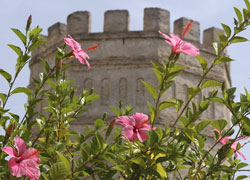 |
| The Moorish Alcazaba of Jerez |
Jerez de la Frontera dates from Phoenician times, but first rose to prominence under the Moors, who called it Xerix or Sherrich ‘De la Frontera’. These names refer to Jerez’s position on the frontier of Moorish Spain, and the Alcazar (fortress) is a reminder of the town’s strategic importance. The real urban development of Jerez began in Moslem times, during the Almoravide and Almohade periods when mosques and palaces were built and the town was extended dramatically.
In the 12 th century the Christians tried on several occasions to capture the city but, for a long period after these failed attempts, Jerez remained a Moorish border town. The eventual re-conquest under Alphonse X saw mosques converted to churches. However, many reminders of Moorish Spain remain in Jerez, including the alcá zar, the 12 th century Almohad fortress with the Capilla Santa María la Real , the Chapel of Santa María la Real and the Baños Arabes, Arab baths. In the Archaelogical Museum you can see a collection of 7 th century BC Greek helmets found in the Río Guadalete. On Plaza del Arenal stands one of Jerez´s loveliest churches, the 16 th century Iglesia de San Miguel, built in Isabelline Gothic style and boasting some beautiful stained - glass windows.
The 19 th century was a period of economic prosperity for Jerez, thanks to a partnership with English exporters and wine merchants launching the success story that the Jerez sherry industry is today.